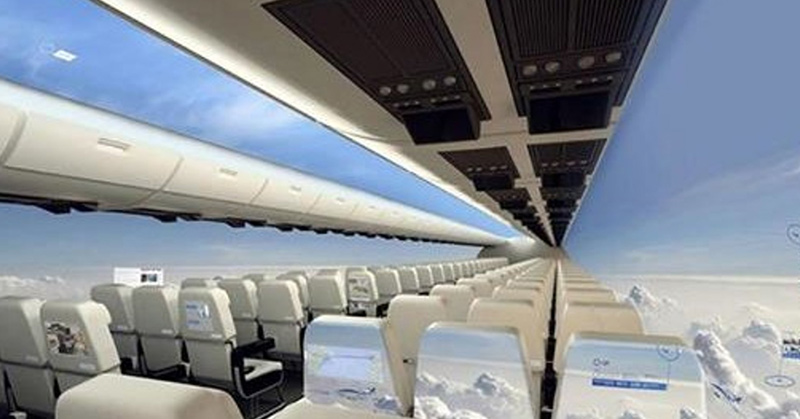Many people prefer the window seat on an airplane. However, what if every seat was a window seat? Imagine being surrounded by the clouds skyline on a windowless plane. If you’ve always dreamed of flight, this may be the dream. But if you have a fear of heights, not so much. Nevertheless, Dubai-based airline, Emirates, plans to initiate this design where “virtual windows” will project the outdoor view for the passengers.
New Windowless Planes With a Stunning View
Emirates’ new cabins are first-class private suites with high-tech features all around. The windows are actually real-time fiber-optic camera technology. In other words, they are screens displaying a live stream of the view just outside the plane. This creates a windowless effect in the plane, and it has a stunning effect. According to Emirates president Sir Tim Clark, the surrounding view was “so good, it’s better than with the natural eye“.
Furthermore, the eventual goal is a cabin with no windows at all. “Imagine now a fuselage as you’re boarding with no windows, but when you get inside, there are windows,” said Sir Tim. “Now you have one fuselage which has no structural weaknesses because of windows. The aircraft are lighter, the aircraft could fly faster, they’ll burn far less fuel and fly higher.”
Aviation expert John Strickland agreed, saying that windowless walls will make a more structurally sound and fuel-efficient aircraft. However, he personally prefers to look outside during a flight. “I’m a bit of a window obsessive. For me, artificial windows would be no substitute.”
Many people agree with Stricklands that windowless planes are not a good idea, but for different reasons.
“Some futuristic concepts show windowless aircraft and, while there may be some structural benefits from getting rid of the windows, there is also another line of thought that says the opposite: having some point of communication with the outside improves the passenger experience,” Victor Carlioz, co-founder of California-based design studio ACLA Studio said to CNN.
Additionally, Saj Ahmad, Chief Analyst at StrategicAero Research, points out the many practical issues that will arise in a windowless plane. “Windowless airplanes would be great in an ideal world from an engineering standpoint — however, in reality, it won’t happen for a number of reasons.”
Safety and Passenger Concerns
One of these reasons is safety concerns with this setup. In case of a technological failure, the screens may go black, making it impossible to see outside during an emergency.
“Being able to see outside the aircraft in an emergency is important, especially if an emergency evacuation has to take place,” said aviation safety expert Professor Graham Braithwaite of Cranfield University. “Flight attendants would need to check outside the aircraft in an emergency, for example for fire, before opening a door and commencing an evacuation — and anything that needed power to do this may not be easy to get certified by an aviation safety regulator.”
However, the European Aviation Safety Agency doesn’t agree with this. According to BBC, they stated, “We do not see any specific challenge that could not be overcome to ensure a level of safety equivalent to the one of an aircraft fitted with cabin windows.”
But then there’s the issue of the passengers’ experience. “Passengers simply do love the natural view outside,” said Ahmad, “and as good as technology is, you can’t beat what the naked eye sees.“
Braithwaite agreed, saying “An aircraft could be very claustrophobic and for many, air travel is anxiety inducing already. The refresh rate of screen technology may also have some undesirable side effects — will they flicker? What is the lag? How will it affect someone on a long-haul flight?”
Also, windowless planes would entail a new method of safety testing and regulation. “There are also regulatory issues too,” Ahmad continued, “the level of change involved would certainly require new tests relating to system redundancy, evacuation, fire suppression as well as pressurization and other stress-related engineering changes.”
The Planes of the Future
However, although issues may arise with windowless planes, the concept appears in other new aircraft plans. For instance, Boeing’s Dreamliner optimizes large windows. Additionally, at the 2011 Paris Air Show, Airbus presented a cabin with clear walls. Then there was Embraer, who created the Kyoto cabin for the Lineage 1000E plane. This cabin also has large windows across its walls.
For now, there are no concrete plans for the Emirates to make windowless planes a reality. However, privately-owned company Spike Aerospace is developing the Spike S-512, according to How Stuff Works. This 18-passenger supersonic business jet will be able to travel faster with less fuel consumption. And no windows. This design also optimizes the virtual skyline experience. The company’s president and chief executive officer Vik Kachoria describes the system as “beautiful, full-length camera feeds from various angles. Whatever image you want to see can be displayed. You can see left or right, in front of the plane or behind it, looking down or up into the sky. It’s more of a panoramic view than the very limited view that you see out of a porthole window.”
For now, only corporate executives and people rich enough to buy a private jet will enjoy the new windowless plane when it is complete. The real question is if this design will become common for commercial airlines as well.
- ‘Are windowless planes the future of travel?’ CNN Francesca Street and Miquel Ros. Published March 27, 2019
- ‘Emirates looks to windowless planes’ BBC Published June 6, 2018
- ‘Windowless Airplanes: The Future of Flight?’ How Stuff Works Patrick J. Kiger. Published Apr 3, 2019

